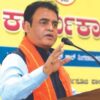Maharashtra: Collateral damage
Dipta Joshi (Mumbai)

Primary school teachers in Maharashtra’s 65,734 government-run zilla parishad (ZP) rural schools are simmering with anger. The state government’s education ministry has directed all teachers to display A4 size photographs of themselves in their classrooms. Additionally, Prashant Bamb, a member of the legislative assembly (MLA) of the ruling Bharatiya Janata Party (BJP) has demanded that the house rent allowance (HRA) of zilla parishad teachers who fail to provide proof of residence in the same village as their school, be withheld.
On Teachers Day (September 5) ZP teachers wore black arm bands to protest this government directive and on September 11, a large contingent of ZP teachers from across the state staged a protest at Aurangabad. Moreover several teachers, who were issued notices to submit proof of residence or forgo their HRA, have reportedly briefed lawyers to contest this government directive.
The prime cause of the impugned directives is widespread belief that highly paid government school teachers — their Pay Commission stipulated remuneration is often 20-30 multiples of teachers in private, especially private budget schools — practice mass truancy. Way back in 1998, a PROBE (People’s Report on Basic Education) survey shocked the nation by stating that 25 percent of government school teachers nationwide are absent from school every day.
This widely cited report was supported in 2005 by the US-based Ithaka think tank’s JUSTOR Report whose authors included Nazmul Chaudhury, a World Bank economist and Kartik Murlidharan, a doctorate scholar at Harvard University and currently professor of economics at the University of California, San Diego (UCSD). “Twenty-five percent of teachers were absent from school, and only about half were teaching during unannounced visits to a nationally representative sample of government primary schools in India. Absence rates varied from 15 percent in Maharashtra to 42 percent in Jharkhand, with higher rates concentrated in the poorer states,” wrote the authors of the report published in the Journal of the European Economic Association (April-May, 2005).
Teachers attribute declining learning outcomes of children in government schools to teachers being assigned a spate of ‘official’ duties outside the classroom which takes away much of their teaching time. According to government school teachers’ spokespersons, they are obliged to discharge 150 non-teaching administrative duties within schools and beyond school gates. These assignments include preparing children’s mid-day meals, maintaining accounts of foodgrains distributed by government to schools, collecting funds for locally sponsored school development projects, submitting reports and updating data required by several administrative departments. Moreover, since July the state’s teachers have been assigned the additional duty of registering children for their Aadhar unique identification cards on the education ministry’s online platform.
In addition, teachers are routinely given assignments to conduct health, animal husbandry, population control drives, door-to-door anti-tobacco awareness campaigns, administer polio vaccine doses, survey the number of public toilets, check open defecation behaviour in villages and even regulate queues outside liquor shops. During the Covid pandemic lockdown, over 300 teachers statewide who were assigned pandemic-related duties lost their lives. Moreover during general and state elections, teachers are assigned booth management and regulation duties.
These extra-curricular duties are routinely assigned to teachers despite s.27 of the Right of Children to Free & Compulsory Education (RTE) Act, 2009, stating “no teacher shall be deployed for any non-educational purposes other than the decennial population census, disaster relief duties or duties relating to elections to the local authority or state legislatures or Parliament.”
“It is unsurprising that teachers are running a campaign demanding the right to teach. Government schools, especially in rural areas don’t have proper infrastructure, lack financial support and make-do with huge teacher vacancies. Most rural schools have only one or two teachers and no support staff because of a government ban on teacher and staff recruitment. Therefore, teachers end up cleaning toilets and even ringing the school bell. If teachers are allowed to do their main job, it would automatically lead to a “sense of belonging between students and teachers” which is being propagated by the education ministry, and learning outcomes would improve,” says Khanderao Dhobale, secretary, Maharashtra State Primary Teachers’ Association.
Evidently in massively mis-governed Maharashtra which has experienced three new governments in the past three years, children’s education is suffering collateral damage.

















Add comment